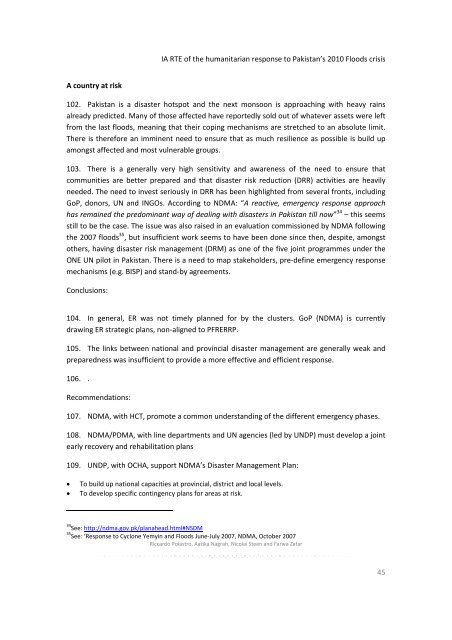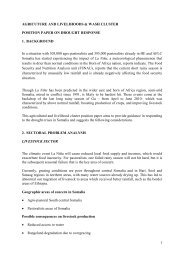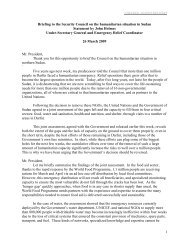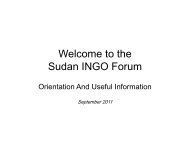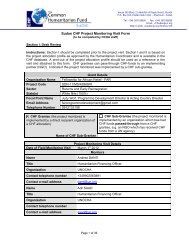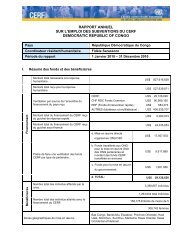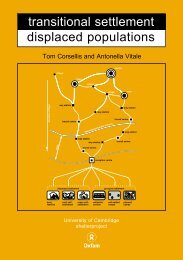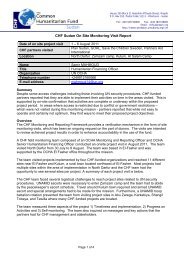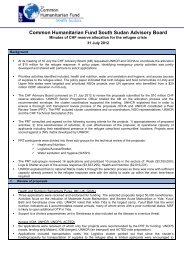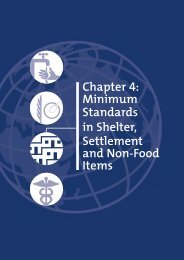Inter-Agency Real Time Evaluation of the Humanitarian ... - OCHANet
Inter-Agency Real Time Evaluation of the Humanitarian ... - OCHANet
Inter-Agency Real Time Evaluation of the Humanitarian ... - OCHANet
Create successful ePaper yourself
Turn your PDF publications into a flip-book with our unique Google optimized e-Paper software.
A country at risk<br />
IA RTE <strong>of</strong> <strong>the</strong> humanitarian response to Pakistan’s 2010 Floods crisis<br />
102. Pakistan is a disaster hotspot and <strong>the</strong> next monsoon is approaching with heavy rains<br />
already predicted. Many <strong>of</strong> those affected have reportedly sold out <strong>of</strong> whatever assets were left<br />
from <strong>the</strong> last floods, meaning that <strong>the</strong>ir coping mechanisms are stretched to an absolute limit.<br />
There is <strong>the</strong>refore an imminent need to ensure that as much resilience as possible is build up<br />
amongst affected and most vulnerable groups.<br />
103. There is a generally very high sensitivity and awareness <strong>of</strong> <strong>the</strong> need to ensure that<br />
communities are better prepared and that disaster risk reduction (DRR) activities are heavily<br />
needed. The need to invest seriously in DRR has been highlighted from several fronts, including<br />
GoP, donors, UN and INGOs. According to NDMA: “A reactive, emergency response approach<br />
has remained <strong>the</strong> predominant way <strong>of</strong> dealing with disasters in Pakistan till now” 34 – this seems<br />
still to be <strong>the</strong> case. The issue was also raised in an evaluation commissioned by NDMA following<br />
<strong>the</strong> 2007 floods 35 , but insufficient work seems to have been done since <strong>the</strong>n, despite, amongst<br />
o<strong>the</strong>rs, having disaster risk management (DRM) as one <strong>of</strong> <strong>the</strong> five joint programmes under <strong>the</strong><br />
ONE UN pilot in Pakistan. There is a need to map stakeholders, pre‐define emergency response<br />
mechanisms (e.g. BISP) and stand‐by agreements.<br />
Conclusions:<br />
104. In general, ER was not timely planned for by <strong>the</strong> clusters. GoP (NDMA) is currently<br />
drawing ER strategic plans, non‐aligned to PFRERRP.<br />
105. The links between national and provincial disaster management are generally weak and<br />
preparedness was insufficient to provide a more effective and efficient response.<br />
106. .<br />
Recommendations:<br />
107. NDMA, with HCT, promote a common understanding <strong>of</strong> <strong>the</strong> different emergency phases.<br />
108. NDMA/PDMA, with line departments and UN agencies (led by UNDP) must develop a joint<br />
early recovery and rehabilitation plans<br />
109. UNDP, with OCHA, support NDMA’s Disaster Management Plan:<br />
� To build up national capacities at provincial, district and local levels.<br />
� To develop specific contingency plans for areas at risk.<br />
34<br />
See: http://ndma.gov.pk/planahead.html#NSDM<br />
35<br />
See: ‘Response to Cyclone Yemyin and Floods June‐July 2007, NDMA, October 2007<br />
Riccardo Polastro, Aatika Nagrah, Nicolai Steen and Farwa Zafar<br />
45


